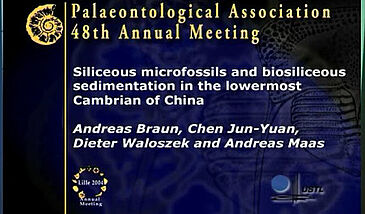En ligne depuis le 08/02/2005
0/5 (0)

Description
Clay-rich and siliceous sedimentary rocks of lowermost Cambrian age on the Yangtze Platform, China contain a large amount of siliceous microfossils. Based on their high content of siliceous hard parts, these rocks are in fact biosiliceous sediments. In more clay-rich lithologies, diagenetic dissolution processes however caused a removal of siliceous hard parts and led to “pure mudstones” and “silicified claystones,” being apparently devoid of siliceous microfossils. Abundant preservation as Fe-hydroxide pseudomorphs and in early diagenetic concretions however indicate a high biosiliceous content of the original sediments. Rocks investigated belong to the lowermost Cambrian (Anabarites trisulcatus – Protohertzina anabarica assemblage zone) and come from black-chert sequences (Kuanshuanpu, S.-Shaanxi province, cf. Chen et al. 2004; Fengkoushao, Yunnan province) as well as sequences of black shales (Nuititang formation, Songtao section, E Guizhou province; Niutitang formation at Mengdong train station, Hunan province). Lighter coloured clay-rich lithologies of equal age in Guizhou (Taozichong section, cf. Wang et al. 1984) have similarly yielded abundant siliceous hardparts.The significant contribution of biosiliceous particles to early Cambrian sedimentation on the Yangtze platform, as well as to other occurrences in Kazakhstan and Europe, implies that silica-biomineralizing organisms have played a significant role in the geochemical cycling of silica in the oceans by the beginning of the Phanerozoic. The high abundance of sponge spicules in the sediments indicates that sponges (Porifera) played a major ecological role in the early Cambrian environment of the investigated areas. This is supported by findings of complete sponges and spicule clusters on bedding planes of clay rich sediments and black shales.
État
- Valorisé
Langues
- Anglais
Licence Creative Commons
- Partage des conditions à l'identique
- Pas d'utilisation commerciale
- Pas de modification
Types
- Grain audiovisuel

